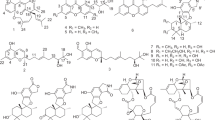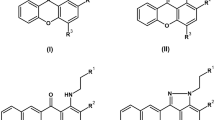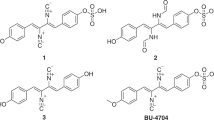Abstract
A new (2) and four known (1, 8–10) sesquiterpenoids, two new (3 and 4) and eight known (5–7, 11–15) xanthone derivatives were isolated from the cultures of sponge-derived fungus Stachybotry sp. HH1 ZDDS1F1-2. The structure of the compounds 1–15 was determined mainly by analysis of the one-dimensional and two-dimensional NMR spectroscopic data and by analogy with the data of those reported. Compound 1 was confirmed by X-ray crystallography. All the compounds were tested for their cytotoxic, antiinflammatory and antiviral (EV71) effects. Compounds 5, 7 and 11 showed significant cytotoxicity against selected human tumor cell lines. Compounds 3, 4 and 11 also displayed significant inhibitory activity against cycloooxygenase (COX-2). Compounds 4, 5 and 11 showed activities against intestinal virus EV71.
Similar content being viewed by others
Log in or create a free account to read this content
Gain free access to this article, as well as selected content from this journal and more on nature.com
or
References
Rateb, M. E. & Ebel, R. Secondary metabolites of fungi from marine habitats. Nat. Prod. Rep. 28, 290–344 (2011).
Huang, R., Peng, Y., Zhou, X., Yang, X. & Liu, Y. A new taurine derivative from South China Sea marine sponge Axinella sp. Nat. Prod. Res. 27, 1537–1541 (2013).
Yang, B., Tao, H., Zhou, X., Lin, X.-P. & Liu, Y. Two new alkaloids from marine sponge Callyspongia sp. Nat. Prod. Res. 27, 433–437 (2013).
Liu, Y. et al. New cyclitol derivative from a sponge Sarcotragus species. Nat. Prod. Res. 25, 648–652 (2011).
Zhou, X. et al. Chemical and biological aspects of marine sponges of the genus Xestospongia. Chem. Biodivers. 7, 2201–2227 (2010).
Li, Y. et al. Chartarlactams A–P phenylspirodrimanes from the sponge-associated fungus Stachybotrys chartarum with antihyperlipidemic activities. J. Nat. Prod. 77, 138–147 (2014).
Koide, H., Hasegawa, K., Nishimura, N., Narasaki, R. & Hasumi, K. A new series of the SMTP plasminogen modulators with a phenylamine-based side chain. J. Antibiot. (Tokyo) 65, 361–367 (2012).
Minagawa, K. et al. Novel stachyflin derivatives from Stachybotrys sp. RF-7260. Fermentation, isolation, structure elucidation and biological activities. J. Antibiot. (Tokyo) 55, 239–248 (2002).
Cacho, R. A., Chooi, Y.-H., Zhou, H. & Tang, Y. Complexity generation in fungal polyketide biosynthesis: a spirocycle-forming P450 in the concise pathway to the antifungal drug griseofulvin. ACS Chem. Biol. 8, 2322–2330 (2013).
Lauren, D. R. et al. Trichothecenes produced by Fusarium crookwellense DAOM 193611. J. Agric. Food Chem. 35, 884–889 (1987).
Hay, J. & Harris, T. Biogenetic-type synthesis of heptaketide natural products: alternariol and lichexanthone. J. Chem. Soc. Chem. Commun. 16, 953b–955b (1972).
Liu, S.-Z. & Zhao, W.-M. Chemical constituents of medicinal fungus Shiraia bambusicola. Chin. Trad. Herb. Drugs 8, 006 (2010).
Arison, B. et al. The delineation of griseofulvin and related systems by nuclear magnetic resonance spectroscopy. J. Am. Chem. Soc. 85, 627–631 (1963).
Tabata, Y. et al. PF1092A, B and C, new nonsteroidal progesterone receptor ligands produced by Penicillium oblatum. II. Physico-chemical properties and structure elucidation. J. Antibiot. 50, 309–313 (1997).
Wu, G., Lin, A., Gu, Q., Zhu, T. & Li, D. Four new chloro-eremophilane sesquiterpenes from an Antarctic deep-sea derived fungus, penicillium sp. PR19N-1. Mar. Drugs 11, 1399–1408 (2013).
Kurihara, K. Synthesis of (±)-PF1092A, B and C; new nonsteroidal progesterone receptor ligands. J. Antibiot. 50, 360–362 (1997).
Yang, J., Qiu, S., She, Z. & Lin, Y. A new xanthone derivative from the marine fungus Phomopsis sp. (No. SK7RN3G1). Chem. Nat. Compd. 49, 246–248 (2013).
Elix, J. A., Musidlak, H. W., Sala, T. & Sargent, M. V. Structure and synthesis of some lichen xanthones. Aust. J. Chem. 31, 145–155 (1978).
Shang, Z., Li, X.-M., Li, C.-S. & Wang, B.-G. Diverse secondary metabolites produced by marine-derived fungus nigrospora sp. ma75 on various culture media. Chem. Biodivers. 9, 1338–1348 (2012).
Wanka, L., Iqbal, K. & Schreiner, P. R. The lipophilic bullet hits the targets: medicinal chemistry of adamantane derivatives. Chem. Rev. 113, 3516–3604 (2013).
Bairwa, K. et al. Rotenoids from Boerhaavia diffusa as potential anti-inflammatory agents. J. Nat. Prod. 76, 1393–1398 (2013).
Ho, H-Y, Cheng, M-L, Weng, S-F, Leu, Y-L & Chiu, DT-Y Antiviral effect of epigallocatechin gallate on enterovirus 71. J. Agric. Food Chem. 57, 6140–6147 (2009).
Acknowledgements
This work was supported financially by the National Key Basic Research Program of China (973)’s Project (2010CB833800 and 2011CB915503), the 863 Program (2012AA092104 and 2013AA092902), the National Natural Science Foundation of China (Nos. 52102308, 31270402, 21172230, 20902094, 41176148, 21002110, 31270402, 21172094 and 41376155), Guangdong Province-CAS Joint Research Program (2011B090300023 and 2012B091100264), and Guangdong Marine Economic Development and Innovation of Regional Demonstration Project (GD2012-D01-001 and GD2012-D01-002).
Author information
Authors and Affiliations
Corresponding authors
Additional information
Supplementary Information accompanies the paper on The Journal of Antibiotics website
Supplementary information
Rights and permissions
About this article
Cite this article
Qin, C., Lin, X., Lu, X. et al. Sesquiterpenoids and xanthones derivatives produced by sponge-derived fungus Stachybotry sp. HH1 ZSDS1F1-2. J Antibiot 68, 121–125 (2015). https://doi.org/10.1038/ja.2014.97
Received:
Revised:
Accepted:
Published:
Issue date:
DOI: https://doi.org/10.1038/ja.2014.97
This article is cited by
-
Perceiving SARS-CoV-2 Mpro and PLpro dual inhibitors from pool of recognized antiviral compounds of endophytic microbes: an in silico simulation study
Structural Chemistry (2022)
-
Recent progresses in marine microbial-derived antiviral natural products
Archives of Pharmacal Research (2020)
-
Marine natural products with anti-inflammatory activity
Applied Microbiology and Biotechnology (2016)



